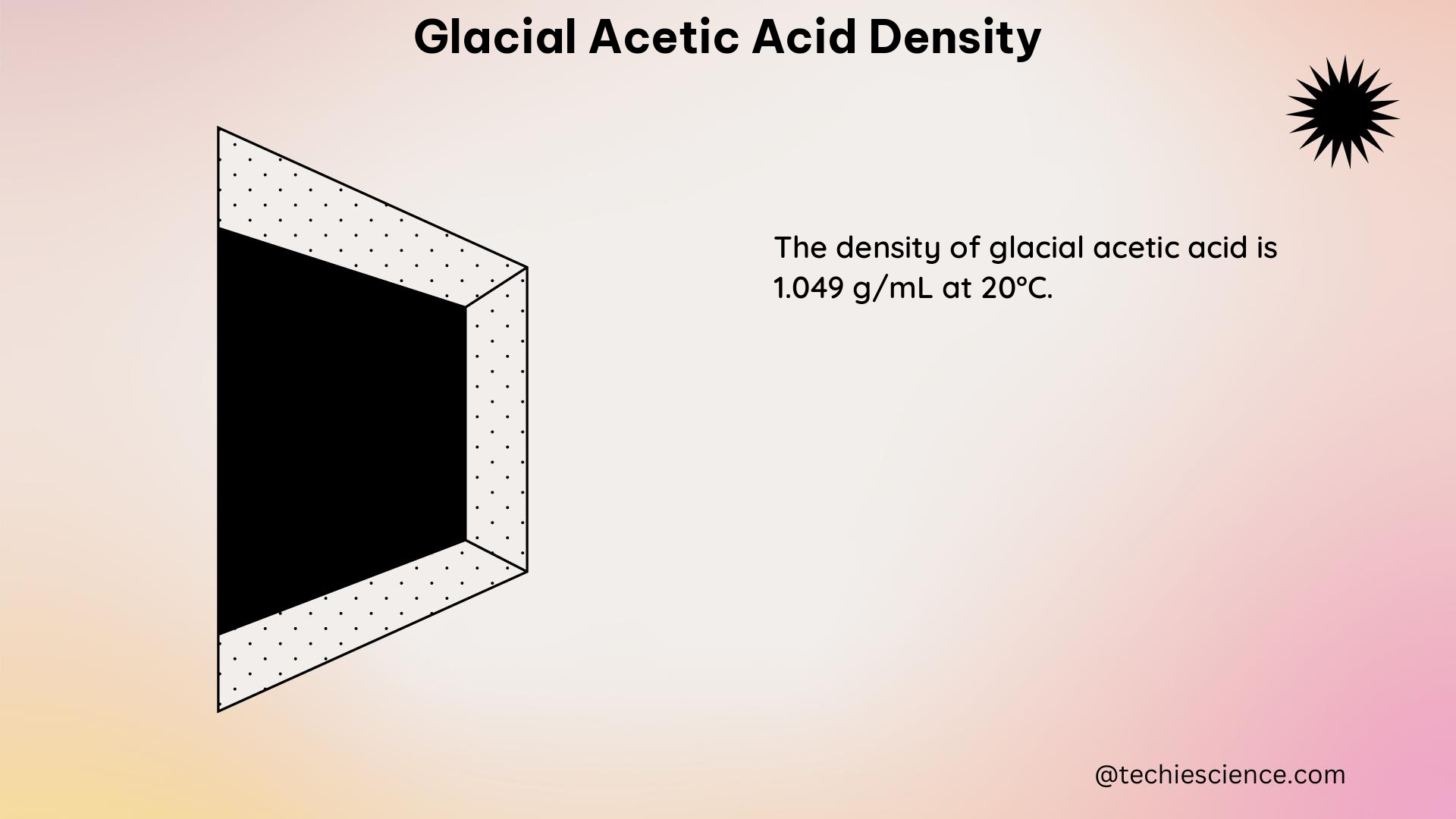Glacial acetic acid, also known as pure acetic acid, is a colorless, corrosive liquid with a pungent odor. It is a widely used chemical in various industries, including the production of pharmaceuticals, textiles, and plastics. One of the critical physical properties of glacial acetic acid is its density, which is essential for understanding its behavior and applications.
Understanding Glacial Acetic Acid Density
The density of glacial acetic acid is a measure of its mass per unit volume. At 25°C, the density of glacial acetic acid is 1.049 g/mL, which means that one milliliter of the liquid has a mass of approximately 1.049 grams. This density value is crucial for various calculations and applications involving glacial acetic acid.
Factors Affecting Glacial Acetic Acid Density
The density of glacial acetic acid can be influenced by several factors, including:
-
Temperature: The density of glacial acetic acid is temperature-dependent. As the temperature increases, the density of the liquid decreases due to thermal expansion.
-
Purity: The presence of impurities in glacial acetic acid can affect its density. Highly pure glacial acetic acid will have a higher density compared to impure samples.
-
Pressure: The density of glacial acetic acid can also be influenced by changes in pressure. As the pressure increases, the density of the liquid typically increases as well.
Calculating Glacial Acetic Acid Density
The density of glacial acetic acid can be calculated using the following formula:
Density = Mass / Volume
Where:
– Density is measured in g/mL
– Mass is measured in grams (g)
– Volume is measured in milliliters (mL)
For example, if you have a sample of glacial acetic acid with a mass of 10.49 grams and a volume of 10 milliliters, the density can be calculated as:
Density = 10.49 g / 10 mL = 1.049 g/mL
This result is consistent with the known density of glacial acetic acid at 25°C.
Other Physical Properties of Glacial Acetic Acid

In addition to its density, glacial acetic acid has several other measurable and quantifiable physical properties that are important to consider:
Molar Mass
The molar mass of glacial acetic acid is 60.05 g/mol. This means that one mole of the substance (6.022 × 10^23 molecules) has a mass of 60.05 grams.
Boiling Point
The boiling point of glacial acetic acid is 118°C at a pressure of 1013 hPa (1 atmosphere). This is the temperature at which the liquid begins to vaporize and turn into a gas.
Melting Point
The melting point of glacial acetic acid is 17°C. This is the temperature at which the solid form of the substance begins to melt and turn into a liquid.
Flash Point
The flash point of glacial acetic acid is 38.5°C. This is the lowest temperature at which the substance can produce a flammable vapor that can ignite in the presence of an ignition source.
pKa Value
The pKa value of glacial acetic acid is 4.74. This is a measure of the substance’s acidity, with lower pKa values indicating stronger acids.
Applications of Glacial Acetic Acid Density
The density of glacial acetic acid is an important property that has various applications, including:
-
Chemical Reactions: The density of glacial acetic acid is used in calculations to determine the stoichiometry and yield of chemical reactions involving the substance.
-
Solubility and Dilution: The density of glacial acetic acid is used to calculate the concentration of the substance in solutions and to determine the appropriate dilution factors for various applications.
-
Process Design and Control: In industrial processes, the density of glacial acetic acid is used to monitor and control the quality and consistency of the final product.
-
Transportation and Storage: The density of glacial acetic acid is an important factor in the design and safety considerations for the transportation and storage of the substance.
-
Analytical Techniques: The density of glacial acetic acid is used in various analytical techniques, such as density-based separation methods and the determination of molecular structure.
Conclusion
The density of glacial acetic acid is a critical physical property that has numerous applications in various industries and scientific fields. Understanding the factors that affect the density of glacial acetic acid, as well as its other measurable properties, is essential for effectively working with and utilizing this versatile chemical substance.
References:
- Acetic acid. (n.d.). In Encyclopædia Britannica. Retrieved from https://www.britannica.com/science/acetic-acid
- Acetic acid. (n.d.). In PubChem. Retrieved from https://pubchem.ncbi.nlm.nih.gov/compound/Acetic-Acid
- Acetic acid glacial ≥98%, TECHNICAL. (n.d.). In VWR. Retrieved from https://sg.vwr.com/store/product/723297/acetic-acid-glacial-98-technical
- Acetic acid glacial ≥99%. (n.d.). In VWR. Retrieved from https://us.vwr.com/store/product/23882753/null
- Glacial acetic acid. (n.d.). In ChemBK. Retrieved from https://www.chembk.com/en/chem/Glacial%20acetic%20acid
- Acetic acid. (n.d.). In ChemSpider. Retrieved from https://www.chemspider.com/Chemical-Structure.64-19-7.html

The lambdageeks.com Core SME Team is a group of experienced subject matter experts from diverse scientific and technical fields including Physics, Chemistry, Technology,Electronics & Electrical Engineering, Automotive, Mechanical Engineering. Our team collaborates to create high-quality, well-researched articles on a wide range of science and technology topics for the lambdageeks.com website.
All Our Senior SME are having more than 7 Years of experience in the respective fields . They are either Working Industry Professionals or assocaited With different Universities. Refer Our Authors Page to get to know About our Core SMEs.